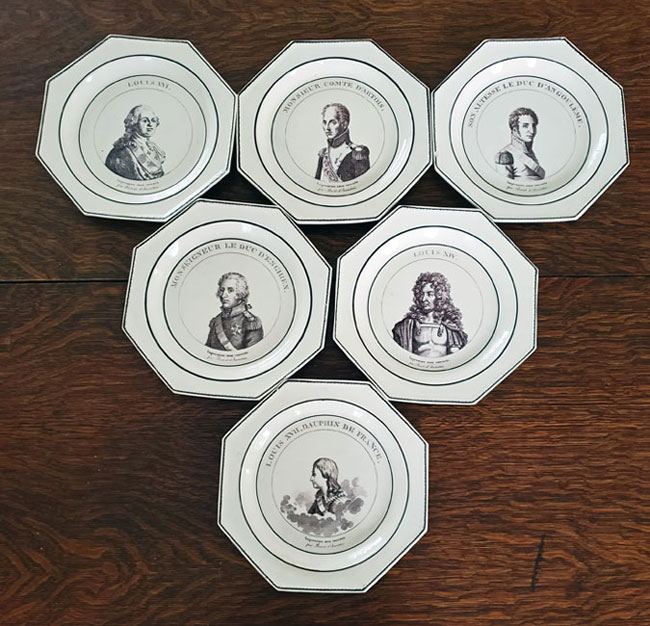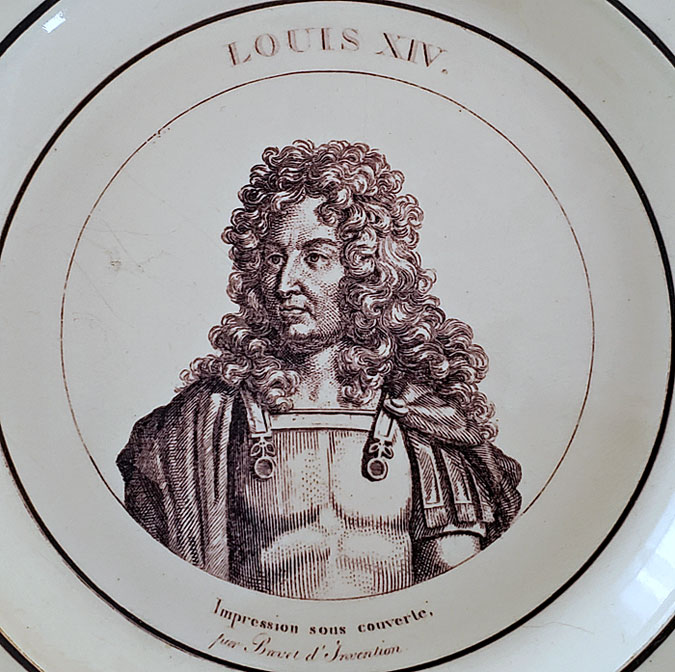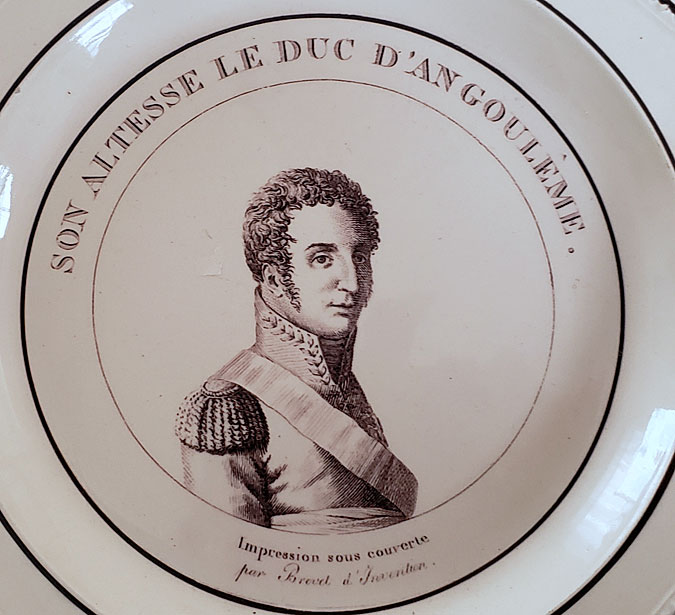 |
Ceramics
19th Century Set of Six French Portrait Plates |
|
|
|
 |
|
These octagonal plates were made by Choisy in France c. 1810. They depict some of the notorious French noblemen of the 18th century and earlier. They are in good condition, with only the occasional minor rim chip, but no cracks. Short biographies of these notables follow:
|
|
Louis XIV, known as Louis the Great or the Sun King, was King of France from 14 May 1643 until his death in 1715. His reign of 72 years and 110 days is the longest recorded of any monarch of a sovereign country in European history. Louis XIV's France was emblematic of the age of absolutism in Europe.
Born: September 5, 1638, Château de Saint-Germain-en-Laye, Saint-Germain-en-Laye, France Died: September 1, 1715, Palace of Versailles, Versailles, France Reign: 14 May 1643 – 1 September 1715 Spouse: Françoise d'Aubigné, Marquise de Maintenon (m. 1683–1715), Maria Theresa of Spain (m. 1660–1683) Children: Louis, Dauphin of France, Louise de Maisonblanche, Nicknames: Louis the Great, Sun King Louis XVI was the last king of France before the fall of the monarchy during the French Revolution. He was referred to as Citizen Louis Capet during the four months just before he was executed by guillotine. In 1765, upon the death of his father, Louis, Dauphin of France, he became the new Dauphin. Born: August 23, 1754, Palace of Versailles, Versailles, France Died: January 21, 1793, Place de la Concorde, Paris, France Spouse: Marie Antoinette (m. 1770–1793) Children: Louis XVII, Marie Thérèse of France Siblings: Louis XVIII, Charles X, Élisabeth of France Parents: Louis, Dauphin of France, Maria Josepha of Saxony, Dauphine of France Louis XVII was the younger son of King Louis XVI of France and Queen Marie Antoinette. His older brother, Louis Joseph, Dauphin of France, died in June 1789, a little over a month before the start of the French Revolution. Born: March 27, 1785, Versailles, France Died: June 8, 1795, Square du Temple, Paris, France Siblings: Marie Thérèse of France, Louis Joseph, Dauphin of France, Sophie of France Parents: Louis XVI, Marie Antoinette Cousins: Louis Antoine, Duke of Angoulême Louis Antoine de Bourbon, Duke of Enghien (Louis Antoine Henri; 2 August 1772 – 21 March 1804) was a member of the House of Bourbon of France. More famous for his death than for his life, he was executed on charges of aiding Britain and plotting against France. Royalty across Europe were shocked and dismayed at his execution. Tsar Alexander I of Russia was especially alarmed, and decided to curb Napoleon's power. Louis Antoine of France, Duke of Angoulême (6 August 1775 – 3 June 1844) was the elder son of Charles X of France and the last Dauphin of France from 1824 to 1830. He was technically[citation needed] King of France and Navarre for less than 20 minutes[1] before he himself abdicated, due to his father's abdication during the July Revolution in 1830. He never reigned over the country, but after his father's death in 1836, he was the legitimist pretender as Louis XIX. He was a petit-fils de France at birth, and was initially known as Louis Antoine d'Artois. After his father's accession to the throne, he became Dauphin de France, and his surname changed to de France, following the royal custom for princes with such rank. Charles X (born Charles Philippe, Count of Artois; 9 October 1757 – 6 November 1836) was King of France from 16 September 1824 until 2 August 1830.[1] An uncle of the uncrowned Louis XVII and younger brother to reigning kings Louis XVI and Louis XVIII, he supported the latter in exile. After the Bourbon Restoration in 1814, Charles (as heir-presumptive) became the leader of the ultra-royalists, a radical monarchist faction within the French court that affirmed rule by divine right and opposed the concessions towards liberals and guarantees of civil liberties granted by the Charter of 1814.[2] Charles gained influence within the French court after the assassination of his son Charles Ferdinand, Duke of Berry, in 1820 and eventually succeeded his brother in 1824.[3][4] His reign of almost six years proved to be deeply unpopular from the moment of his coronation in 1825, in which he tried to revive the practice of the royal touch. The governments appointed under his reign reimbursed former landowners for the abolition of feudalism at the expense of bondholders, increased the power of the Catholic Church, and reimposed capital punishment for sacrilege, leading to conflict with the liberal-majority Chamber of Deputies.[4] Charles also initiated the French conquest of Algeria as a way to distract his citizens from domestic problems. He eventually appointed a conservative government under the premiership of Prince Jules de Polignac, who was defeated in the 1830 French legislative election. He responded with the July Ordinances disbanding the Chamber of Deputies, limiting franchise, and reimposing press censorship.[5] Within a week France faced urban riots which led to the July Revolution of 1830, which resulted in his abdication and the election of Louis Philippe I as King of the French. Exiled once again, Charles died in 1836 in Gorizia, then part of the Austrian Empire.[3] He was the last of the French rulers from the senior branch of the House of Bourbon. |
|
More detailed biographies may be found online or in your French history book.
|
|
$875.00 the set
|
|
Ask Us About: L11
Call us anytime to discuss this or any other item, as well as our convenient terms.
|
 |
 |
 |
|
Hanes & Ruskin Antiques and Appraisals Joy Hanes 97 West Main Street # 79 Niantic, CT 06357 860.304.2146 |